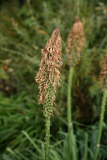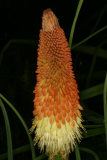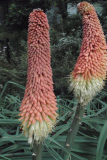Additional notes (click to expand)
Commemorative
A spectacular red-hot poker from South Africa which commemorates Johann Hieronymus Kniphof
(1704–63), professor of medicine at Erfurt University in Germany. He was famous for his 10-volume work Botanica in originali seu herbarium vivum in quo plantarum... (1759–64), which contained 1,189 pictures of plants each produced by coating the plant in (black) printer’s ink and then pressing it carefully onto the paper to produce a life-size image. These were then coloured by hand. Like a herbarium specimen, if the plant was too large for the page then the stem would be cut and it would be displayed in two parts. The whole process was hugely laborious and each specimen could only be used to make fi ve prints, so thousands of plants were needed – and of course the pages could only be printed when the plants were in fl ower. Only 10 complete copies are known to have survived. This was the first botanical atlas to use the Linnaean system of classification.
Oakeley, Dr. Henry. (2012). Doctors in the Medicinal Garden. Plants named after physicians. Royal College of Physicians. p.91
link
Horticulture
Kniphofia caulescens, a perennial in the family Asphodelaceae, hails from South Africa. In late summer, at the front of a sunny, well-drained border, it produces spikes of orange-flushed, cream flowers against glaucous leaves. Despite being borderline frost-hardy, it survives outside with an annual mulch of bark for protection.(Clare Beacham)
Oakeley, Dr. Henry. (2012). Doctors in the Medicinal Garden. Plants named after physicians. Royal College of Physicians.
link
Medicinal
Kniphofia have been used in ‘muthi’ medicine (South African traditional medicine) as a snake repellent and for chest complaints, but they contain toxic chemicals, knipholone compounds, and should not be eaten.
Oakeley, Dr. Henry. (2012). Doctors in the Medicinal Garden. Plants named after physicians. Royal College of Physicians. p.91
link
Other use
Kniphofia are pollinated by birds and insects.
Toxicity
They contain toxic chemicals, knipholone compounds, and should not be eaten.
Oakeley, Dr. Henry. (2012). Doctors in the Medicinal Garden. Plants named after physicians. Royal College of Physicians.
link
A few reports of toxicity.
Professor Anthony Dayan, 2022
Geographical distribution
- Africa, Southern Africa, Lesotho
Kniphofia caulescens Baker ex Hook. f.
Family: ASPHODELACEAEGenus: Kniphofia
Species: caulescens Baker ex Hook. f.
Common names: Caulescent Red Hot Poker
Distribution summary: South Africa
Habit: Perennial
Hardiness: H4 - Hardy; average winter
Habitat: Sunny, dry, rocky hill
Garden status: Currently grown
Garden location: Southern Hemisphere (K)
Flowering months: July, August
Reason for growing: Commemorative, medicinal, toxic
.JPG)
.JPG)



.JPG)
.JPG)
.JPG)




.JPG)
.JPG)
.JPG)